For investors looking to build an on-demand grocery delivery app, it's essential to understand the market potential and key development factors.
Start by analyzing user demand, competitor strategies, and revenue models.
Invest in a reliable tech stack, a seamless user experience, and essential features like real-time order tracking, secure payments, and efficient delivery management.
Scalability, data security, and compliance should be prioritized to ensure long-term growth.
With the right strategy and development team, investing in a grocery delivery app can offer high returns in a rapidly expanding digital commerce market.
By keeping all these factors in mind, you can set the stage for a highly successful grocery delivery app.
Let’s Begin:
What is a Grocery Delivery App?
A grocery delivery app is a digital platform that allows users to buy groceries online without facing any issues right at their doorsteps.
Businesses looking to tap into this growing market often choose to create an app that combines efficiency, user-friendliness, and seamless logistics for maximum customer satisfaction.
Let's dive into the essential features of a grocery delivery app and gain insights into its functionality, following a comprehensive grocery delivery app development guide.
How Does a Grocery Delivery App Work?
A grocery delivery app allows users to browse their favourite products and schedule deliveries according to their time.
For investors interested in developing a grocery delivery app, understanding its core is essential.
Moving forward with the on-demand grocery delivery app development guide, we will take a look essential points that can drive the success of your app:
-
User registration and login enable customers to create an account, securely store their information, and access personalized settings.
-
Restaurant listings display a curated selection of nearby restaurants, allowing users to explore various dining options based on their preferences, such as cuisine type, ratings, and distance.
-
Menu browsing allows users to easily explore a restaurant’s offerings directly through the app.
-
Search & Filters allow users to quickly find specific dishes or restaurants by entering keywords.
-
Order Place allows users to easily add items to their cart, review selections, customize orders, and choose payment methods.
-
Real-time order tracking enables users to monitor their order’s progress from preparation to delivery.
Grocery Delivery App Statistics
Demand for grocery delivery apps is experiencing rapid growth, fuelled by increasing consumer demand for convenience and speed.
-
The industry is projected to reach a staggering $1.89 trillion by 2029.
-
According to recent reports, 58% of all online grocery orders are placed through mobile apps, emphasizing the critical role of mobile-first platforms in the sector.
-
In major urban areas, average delivery times have dropped to as little as 30 minutes, showcasing the shift toward instant and efficient service.
-
With an expected annual growth rate of 7.83% between 2025 and 2029, the grocery delivery segment is set to contribute significantly to this booming market.
The growing demand is fuelling innovation, prompting more businesses to adopt advanced technologies such as AI, real-time tracking, and personalized recommendations to elevate the overall user experience.
Why Invest in a Grocery Delivery App in 2025?
With rising demand for convenience and digital shopping, investing in a grocery delivery app offers strong growth potential.
In 2025, here are some top reasons to build a grocery delivery app:
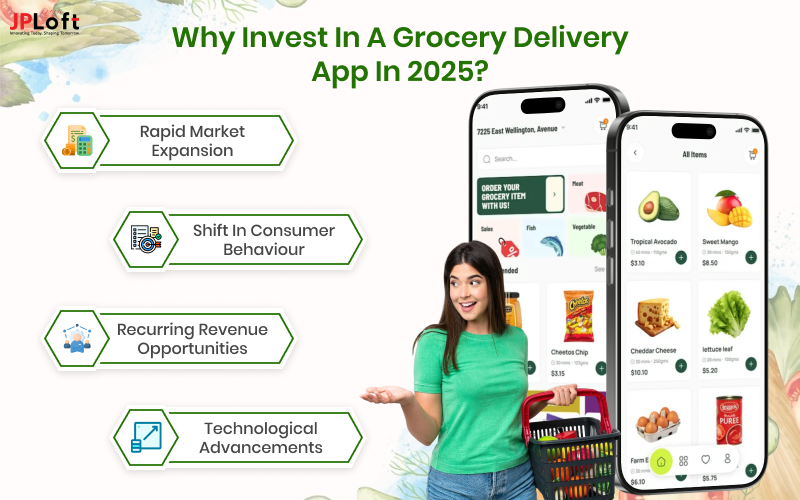
A] Rapid Market Expansion
You must have noticed a rapid expansion in grocery delivery apps, with a market share that is increasing and emerging opportunities.
Businesses that develop a grocery delivery app can tap into this expanding market, reaching more customers and securing a competitive edge in 2025.
B] Shift in Consumer Behaviour
Consumer behaviour has significantly shifted toward online grocery shopping, with more people prioritizing convenience, speed, and ease of access to essential products.
If you carefully build a grocery delivery app aligning with this trend, you can offer user a faster, easier, and more flexible shopping experience.
C] Recurring Revenue Opportunities
When you create a grocery delivery app, you open doors to recurring revenue through subscription plans, delivery charges, and in-app promotions.
The constant demand for groceries ensures a steady user base, making it a reliable and scalable business model.
D] Technological Advancements Enabling Better Scalability
Advancements in technology, like AI, real-time tracking, and cloud infrastructure, make it easier to build a grocery delivery app that’s scalable and efficient.
These innovations help streamline operations, enhance user experience, and support rapid growth as demand continues to rise.
Now that we've explored the key reasons to invest in a grocery delivery app, let’s take a look at the essential features that make it successful.
Core Features of Grocery Delivery Apps
While developing a food delivery app, one important question to consider is how to build a grocery delivery app with standout features that set you apart in a competitive market and attract a loyal customer base.
To help you with your query, here are some essential and advanced features of grocery apps that can provide you with an edge over others.
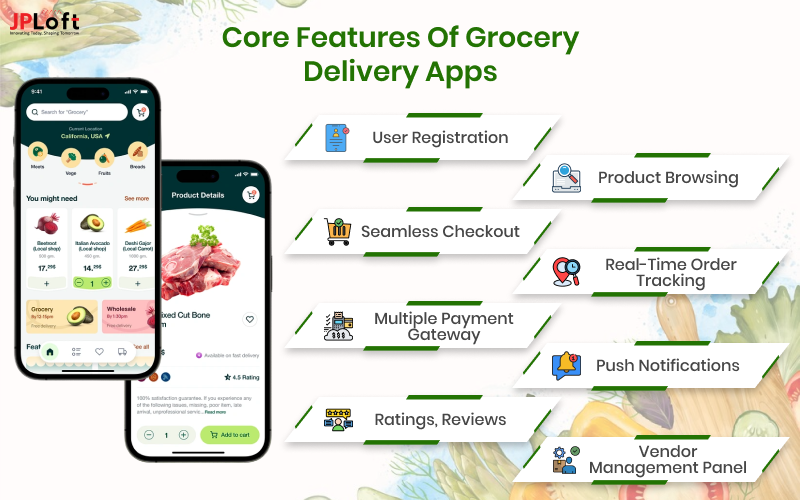
1. User Registration & Profiles
If you want to create something engaging, you should create a grocery delivery app
that offers convenience, speed, and reliability to users.
By combining intuitive design, essential features like real-time tracking and multiple payment options, and seamless performance, you can deliver a user experience that keeps customers coming back.
With the growing demand for online grocery shopping, it’s the perfect time to enter the market with a solution that stands out and meets everyday consumer needs.
2. Product Browsing & Advanced Search
Develop a grocery delivery app to meet growing consumer demand for convenience and speed.
By integrating essential features like secure payments, personalized recommendations, and a seamless user experience, you can create a powerful platform that not only attracts users but also builds long-term customer loyalty.
3. Smart Cart & Seamless Checkout
Build a grocery delivery app with Smart Cart that offers seamless features that enhance the user experience.
Smart Cart suggests items based on preferences, while checkout ensures quick, hassle-free payments.
Boost customer satisfaction and streamline the shopping experience with these intelligent features in your grocery delivery solution.
4. Real-Time Order Tracking
Real-time order tracking is a key feature many top solutions include.
Partner with the best mobile app development company to build innovative, high-performing apps tailored to your business goals and audience.
It improves transparency, boosts customer trust, and ensures timely deliveries, making it essential for any modern grocery delivery app.
5. Multiple Payment Gateway Integration
Integrating multiple payment gateways is crucial when you develop a grocery delivery app.
It offers users flexibility with various payment options like credit cards, wallets, and UPI.
This boosts convenience, reduces cart abandonment, and ensures smooth, secure transactions, enhancing the overall shopping experience for your customers.
6. Push Notifications & Alerts
Build a grocery delivery app with push notifications and alerts to keep users engaged and informed.
Notify customers about order updates, special offers, and delivery status in real-time.
This feature boosts user retention, enhances communication, and ensures a more personalized and responsive shopping experience for every customer.
7. Ratings, Reviews & Feedback
Ratings, reviews, and feedback are essential features when you build a grocery delivery app.
They allow customers to share suggestions based on their experiences, helping businesses improve through genuine user insights.
By encouraging feedback, companies build trust, enhance credibility, and foster a loyal customer base through open communication and transparency.
8. Admin & Vendor Management Panel
When you develop a grocery delivery app, a management panel is essential.
This feature allows seamless control over inventory, order management, and vendor interactions.
Admins can monitor performance and track delivery, manage, and ensure smooth operation with efficient communication, ultimately enhancing the user experience.
Now that we've explored all the key features of a grocery delivery app, let’s take a look at how the app actually works.
Grocery Delivery App Development Process
Developing a grocery delivery app is an exciting yet complex process that involves several stages, from ideation to launch and post-launch support.
With the rising demand, the grocery delivery apps have gained immense popularity, offering consumers a time-saving experience.
Below is a detailed breakdown of the grocery delivery app development process, including key stages, required features, and tips for success.
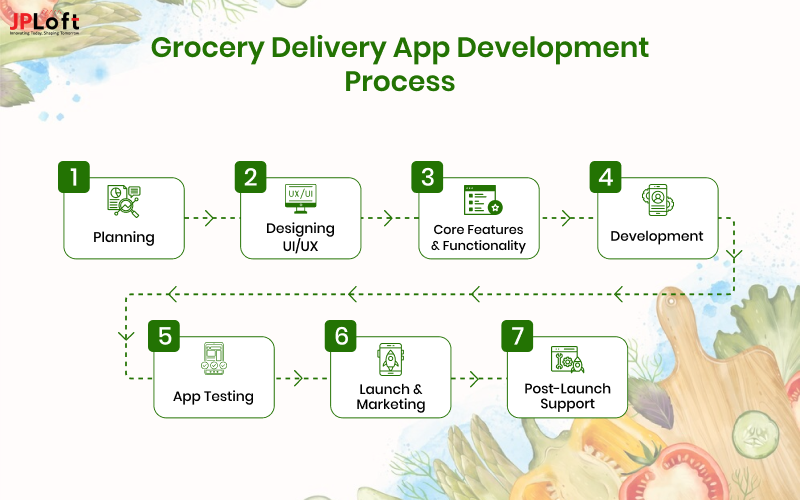
Step 1: Conceptualization and Planning
The first step in the grocery delivery app development guide is conceptualization and planning.
This involves identifying the core features and targeting the proper audience by analyzing the competitors.
During this phase, businesses outline the app’s goal by checking the delivery model.
Market research is conducted to understand user needs and current trends.
A clear roadmap is then developed, outlining the budget, timeline, and key milestones to ensure the development process aligns seamlessly with both business goals and user expectations.
Step 2: Designing the User Interface (UI/UX)
Designing the UI/UX is a crucial step focused on creating an intuitive, visually appealing, and user-friendly experience.
It includes wireframing, prototyping, and crafting layouts that enable smooth navigation and easy access to key features such as product browsing, adding items to the cart, and seamless checkout.
The main objective is to minimize friction, enhance usability, and keep users engaged.
A well-designed interface not only boosts user satisfaction but also builds trust and encourages repeat use of the grocery delivery app.
Step 3: Core Features and Functionality
This stage involves integrating essential features that define the app's value and usability.
Key functionalities include user registration, product search with smart filter, and cart management, offering multiple payment options.
These features ensure a smooth and convenient shopping experience for users.
Incorporating admin and vendor panels also allows seamless management of inventory, orders, and user data, making the app efficient for both customers and businesses.
Step 4: Development
In the development phase, the app is brought to life through coding and integration.
Frontend and backend development teams work together to build user interfaces, implement features like product browsing, cart management, and payment gateways, and ensure smooth communication between servers and databases.
APIs are integrated for added functionalities, and performance optimization is carried out to ensure the app runs smoothly across different devices and platforms.
Step 5: App Testing and Optimization
Once development is complete, the app undergoes rigorous testing to ensure reliability and a seamless user experience.
This includes functional testing, usability testing, performance testing, and security checks. Any bugs or glitches are identified and resolved.
User feedback from beta testing may also be gathered to refine the app before launch, ensuring it meets quality standards and user expectations.
Step 6: Launch and Marketing
After thorough testing, the app is ready for launch on platforms like the App Store and Google Play Store.
A strategic marketing plan is essential to create buzz and attract users.
This may include social media promotions, influencer partnerships, app store optimization (ASO), and targeted ad campaigns.
Effective marketing ensures visibility, drives downloads, and helps establish the app in a competitive market, setting the foundation for long-term success.
Step 7: Post-Launch Support & Updates
After launch, continuous support and regular updates are essential to maintain app performance and user satisfaction.
This includes monitoring for bugs, resolving technical issues, and gathering user feedback to guide improvements.
Updates may involve adding new features, enhancing security, or refining the user experience.
Ongoing app maintenance services ensure the app remains competitive, reliable, and aligned with evolving user needs, fostering long-term engagement and customer loyalty.
Now that we've shared the grocery delivery app development process, let’s dive into the detailed process of building your food delivery app.
Top Grocery Delivery Apps in 2025
Let’s explore how to make a grocery delivery app that performs effectively in a competitive market.
Take a look at the features of these apps to stay competitive and understand user opinions, since they are the ones directly experiencing and evaluating the app’s performance.
Here are some top apps that rule the market:
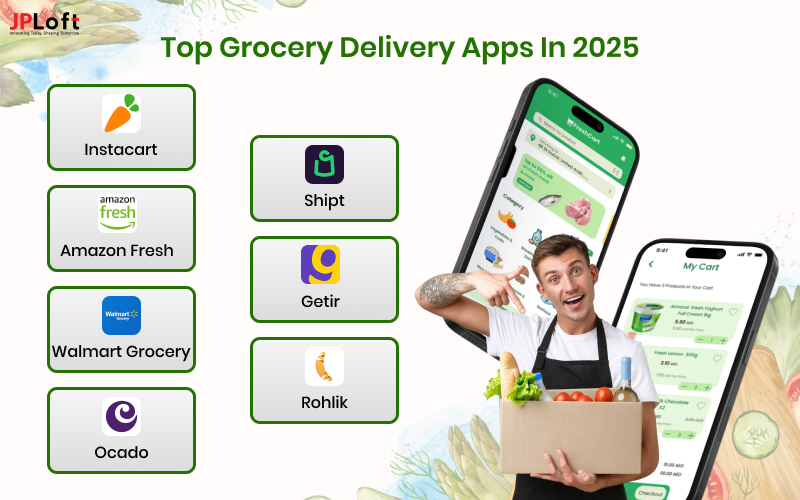
1. Instacart
Instacart is a leading U.S.-based grocery delivery platform that partners with a wide range of major retailers, including national chains and local stores, to offer convenient same-day delivery and curbside pickup services.
By connecting customers with personal shoppers who handpick items based on user preferences and real-time inventory, Instacart ensures a smooth, reliable, and highly personalized shopping experience.
2. Amazon Fresh
Amazon Fresh is a grocery delivery app by Amazon that offers fast delivery of fresh produce, pantry staples, and household essentials, integrated seamlessly with Amazon’s ecosystem and Prime membership.
These apps combine the power of advanced logistics, real-time inventory management, and user-friendly features like voice ordering via Alexa and personalized recommendations.
3. Walmart Grocery
Walmart Grocery is an online grocery delivery and pickup app from Walmart, offering a wide selection of fresh produce, household essentials, and everyday items at affordable prices and nationwide availability.
Customers can conveniently shop via the mobile app or website, schedule deliveries, and enjoy real-time order tracking and seamless payment options.
4. Ocado
Ocado is a UK-based online-only grocery retailer known for its advanced automation, vast product range, and partnerships with major supermarket chains, delivering fresh food and essentials straight to customers’ doors.
With cutting-edge robotic warehouses and AI-driven logistics, Ocado ensures efficient order fulfilment, timely deliveries, and a highly personalized shopping experience for its users.
5. Shipt
Shipt is a U.S.-based grocery delivery app owned by Target, offering same-day delivery of groceries, household essentials, and other products from local stores with a focus on convenience and customer satisfaction.
Members can schedule deliveries, communicate with personal shoppers in real time, and enjoy a user-friendly app designed for a smooth shopping experience.
6. Getir
Getir is a fast-growing Turkish delivery app offering ultrafast delivery of groceries, essentials, and more.
Operating in multiple countries across Europe, Getir promises deliveries in as little as 10 minutes.
7. Rohlik
Rohlik is a top online grocery delivery app in Central Europe, offering fresh produce, pantry staples, and household essentials.
Operating in countries like the Czech Republic, Hungary, and Germany, it focuses on fast, reliable delivery.
Now that we’ve explored the top features of these companies, let’s take a look at the cost involved in integrating these features into a grocery delivery app.
Cost to Develop a Grocery Delivery App
One of the big parts in the grocery delivery app development guide is to know how much does it costs to build a grocery delivery app.
The overall cost to create a grocery delivery app can go from $20,000 to $250,000+, depending on various factors.
The complexity of the features, app design, and development process all contribute to the overall cost.
For instance, basic grocery delivery apps with essential features like product catalogues, carts, and checkouts will be on the lower end of the price range.
However, apps with advanced functionalities such as real-time order tracking and push notifications with multiple payment integrations can significantly cost you more.
The choice of platform (iOS, Android, or both) also affects the overall cost to create an app, as developing for multiple platforms requires more resources.
Regulatory Compliance For Grocery Delivery App
When developing a grocery delivery app, ensuring regulatory compliance is crucial to operating legally, protecting user data, and building trust with customers.
Failing to meet legal and industry standards can lead to penalties, damaged reputation, and loss of customer confidence.
That’s why understanding the compliance requirements is a key part of planning how to create a grocery delivery app that is both reliable and sustainable.
Here are some key features essential for a successful grocery delivery app.
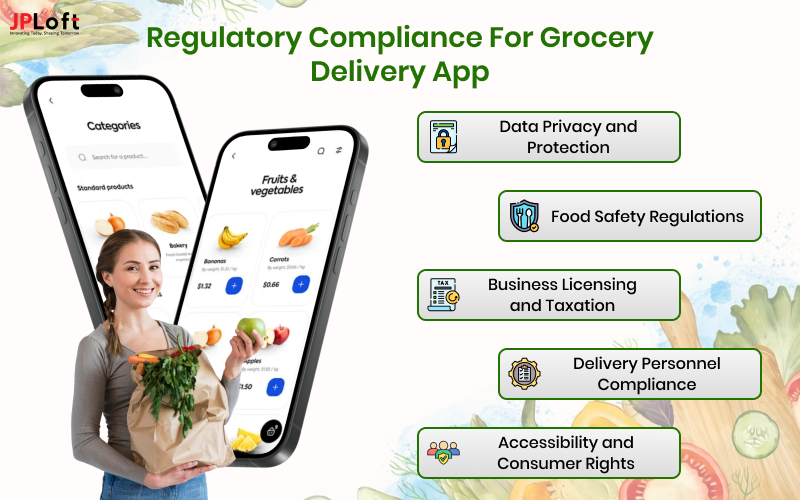
► Data Privacy and Protection
One of the most important aspects of regulatory compliance is safeguarding user data.
Grocery delivery apps must adhere to major data privacy laws such as the General Data Protection Regulation (GDPR) in the EU and the California Consumer Privacy Act (CCPA) in the U.S.
These regulations mandate transparency and accountability in how user data is collected, stored, and used.
To stay compliant, apps should implement robust security measures like end-to-end encryption, secure payment gateways, and clear user consent protocols.
Regular updates and security audits – often part of ongoing mobile app maintenance are also essential to ensure data protection standards.
► Food Safety Regulations
Since the app facilitates the sale and delivery of groceries, it must ensure that all listed products comply with local food safety laws.
This includes proper labelling, expiry date visibility, storage requirements, and transportation conditions.
For example, perishable goods must be handled and delivered under temperature-controlled conditions to maintain quality and avoid legal issues.
► Business Licensing and Taxation
All operators and vendors are required to possess and maintain valid business licences in order to legally sell groceries through the platform.
This ensures compliance with local regulations and helps build trust with consumers.
Furthermore, the application must seamlessly integrate with regional tax calculation systems to automatically compute and apply the correct amount of sales tax or value-added tax (VAT), based on the buyer’s location.
► Delivery Personnel Compliance
When learning how to create a grocery delivery app, it’s important not to overlook regulatory requirements related to delivery personnel.
These individuals play a key role in the customer experience, and ensuring their compliance with legal standards is essential for smooth operations and brand trust.
Delivery drivers must meet certain criteria depending on the region.
This typically includes holding a valid driver’s licence, having vehicle insurance, and undergoing background checks to ensure safety and reliability.
In many areas, drivers may also need to complete food handling or health and safety training, especially when transporting perishable or temperature-sensitive items.
► Accessibility and Consumer Rights
Apps must comply with regulations that ensure equal access, including features for users with disabilities.
Transparency in pricing, refund policies, and complaint resolution mechanisms is also required under consumer protection laws.
Meeting these regulatory standards not only avoids legal consequences but also enhances the app’s credibility and user trust.
It creates a safer, more transparent, and user-friendly environment that encourages long-term engagement and brand loyalty.
Challenges in Developing a Grocery Delivery App
Developing a grocery delivery app isn’t smooth sailing. There are several obstacles that one might face.
From smooth services to app privacy, issues can be interconnected, with one problem potentially affecting the other.
In this section on how to create a grocery delivery app, we will address the key challenges and considerations involved throughout the development process.
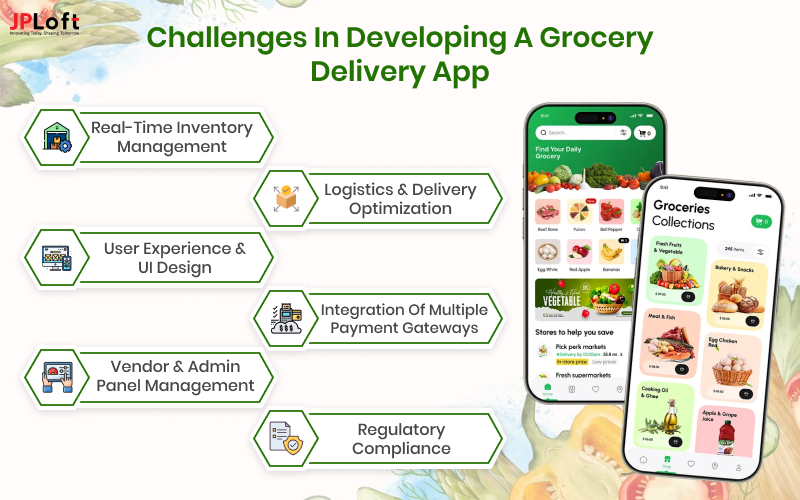
A] Real-Time Inventory Management
Managing inventory in an on-demand grocery delivery app can be a complex part, especially while dealing with a wide range of products.
Solution: Implement real-time inventory tracking to ensure accurate stock levels, reduce the risk of stockouts or overstocking, and enable faster, data-driven decision-making.
Ensuring product availability enhances operational efficiency and improves customer satisfaction.
B] Logistics & Delivery Optimization
Coordinating deliveries efficiently while minimizing costs and ensuring timely arrival can be complex, especially as order volumes increase.
Solution: Utilize advanced route planning, real-time tracking, data analytics, and automation to streamline the delivery process.
This reduces transit times, enhances resource allocation, and improves overall efficiency, resulting in timely deliveries, greater customer satisfaction, and higher profitability.
C] User Experience & UI Design
Creating an intuitive and visually appealing interface that meets user needs while ensuring seamless navigation can be challenging.
Solution: Work on prototype and wireframes to map out functionality and user flow.
This approach helps identify user needs early, enhances usability, and sets the stage for a smooth and successful app development process, leading to a better overall user experience.
D] Integration of Multiple Payment Gateways
Offering diverse and secure payment options while ensuring smooth transactions can be difficult, especially with varying user preferences and regional payment systems.
Solution: Integrate multiple payment gateways to provide flexible, secure, and convenient transaction methods.
This minimizes cart abandonment, fosters customer trust, and supports seamless global transactions, optimizing payment processing and driving higher sales across various devices and regions.
E] Vendor & Admin Panel Management
Managing vendors and administrative tasks efficiently can be challenging, particularly with real-time updates, vendor onboarding, and inventory control.
Solution: Implement an intuitive vendor and admin panel that simplifies operations, streamlines performance tracking, and allows seamless management of vendors and inventory.
This solution enhances decision-making, boosts productivity, and provides a convenient mobile platform for both administrators and vendors.
F] Regulatory Compliance & Data Security
Ensuring compliance with industry regulations and protecting sensitive user data can be complex, particularly with evolving security threats.
Solution: Implement robust security measures that adhere to industry standards, including encryption, secure authentication, and regular audits.
This approach minimizes risk, safeguards user data, and fosters trust, providing peace of mind for businesses and their stakeholders.
Future Trends in Grocery Delivery App
Developing a grocery delivery app presents unique challenges, including real-time inventory management and efficient logistics, while delivering a seamless user experience.
In today’s competitive market, offering something unique is essential to stand out. Get to know the future trends shaping this industry:
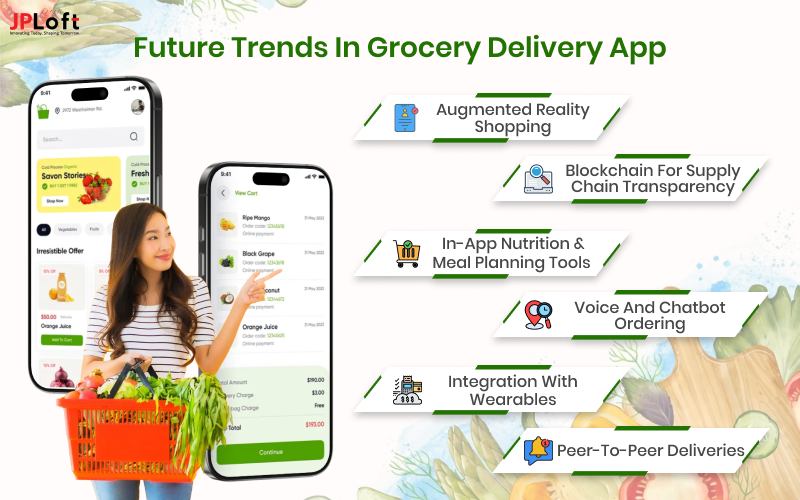
1. Augmented Reality (AR) Shopping
Augmented Reality (AR) Shopping allows users to visualize grocery items in their home environment before purchasing.
This technology enables customers to see how products, like furniture or kitchen items, will look in their space.
It enhances the shopping experience, improving decision-making and customer satisfaction within grocery delivery apps.
2. Blockchain for Supply Chain Transparency
Blockchain technology enhances supply chain transparency by providing a secure, tamper-proof ledger of transactions.
It allows real-time tracking of products from source to shelf, ensuring authenticity and reducing fraud.
With improved traceability and accountability, businesses can build trust with consumers and streamline operations through more
3. In-App Nutrition and Meal Planning Tools
Integrating in-app nutrition and meal planning tools into the grocery delivery app development process enhances user engagement and adds value.
These features help users make healthier food choices, personalize shopping lists, and plan balanced meals, creating a smarter, more convenient shopping experience within groceries.
They also encourage long-term app usage by aligning with users’ wellness goals and simplifying their daily routines.
4. Voice and Chatbot Ordering
Voice and chatbot ordering will streamline the grocery shopping experience by allowing users to place orders through simple voice commands or chat messages.
Powered by AI, these tools offer convenience, speed, and hands-free interaction, making grocery shopping more accessible.
They also enhance user satisfaction by providing quick assistance, personalized suggestions, and 24/7 support within the app.
Additionally, these features help businesses lower operational costs by automating customer support and simplifying the ordering process, reducing the need for manual intervention.
5. Integration with Wearables
Integration with wearables will enable grocery apps to access real-time health and fitness data from devices like smartwatches.
This allows for personalized grocery suggestions based on activity levels, dietary goals, or specific health conditions, ensuring users receive items that align with their unique wellness needs.
By leveraging real-time data, users are empowered to make smarter food choices, stay on track with nutrition plans, and maintain a consistent, balanced, and health-conscious shopping routine.
6. Crowdsourced and Peer-to-Peer Deliveries
Crowdsourced and peer-to-peer deliveries are transforming grocery logistics by enabling local individuals to deliver orders within their communities.
This model reduces delivery times, lowers operational costs, and expands service to hard-to-reach areas.
It also fosters community involvement and provides earning opportunities for locals.
By leveraging real-time tracking and secure payment systems, these decentralized networks offer a flexible, scalable, and customer-friendly alternative to traditional delivery models.
How JPLoft Can Help Develop a Grocery Delivery App?
A trusted grocery app development company, JPLoft specializes in building innovative and scalable grocery delivery solutions tailored to modern consumer needs.
With over 10 years of experience in mobile and web development, we craft user-friendly platforms equipped with powerful features such as smart search, secure payment gateways, order scheduling, and real-time push notifications.
Our experienced team works hand in hand with clients to understand their unique business goals and develop tailored apps that enhance customer satisfaction and streamline operational efficiency.
By integrating cutting-edge technologies such as AI, machine learning, and data analytics, the company enhances personalization and optimizes delivery logistics.
Whether you're a startup or an established retailer, you can count on a seamless development process– from concept and design to launch and long-term support.
As a trusted development partner, we empower businesses to thrive and maintain a competitive edge in the constantly evolving online market.
Conclusion
Wrapping it up, the grocery delivery app market isn’t just growing – it’s exploding, fueled by consumers who crave convenience and speed.
To stay ahead in this competitive space, businesses must offer the essentials: seamless real-time tracking, secure and hassle-free payments, and smart recommendations that truly understand customer needs.
With AI and machine learning stepping into the spotlight, these apps are becoming more intelligent, adapting to user behaviour, optimising experiences, and making shopping effortless.
For startups and modern entrepreneurs, it’s not about avoiding trends — it’s about embracing them, standing out, and building loyal customer bases in this fast-evolving industry.
The future of online grocery shopping is fast, intelligent, and built for convenience, driven by innovation and a relentless pursuit of excellence.
FAQs
To create a grocery delivery app, define core features, design a user-friendly interface, develop functionality, and launch with effective marketing
The cost varies based on features, design complexity, platform (iOS/Android/Web), and development time.
Grocery delivery apps ensure secure payments by integrating encrypted payment gateways, using SSL certificates, and complying with PCI-DSS standards.
AI will optimize food delivery logistics by predicting demand, improving route planning, reducing delivery times, and enhancing operational efficiency.
Grocery delivery apps can improve customer retention by offering personalized recommendations, loyalty programs, fast delivery, and excellent customer support.





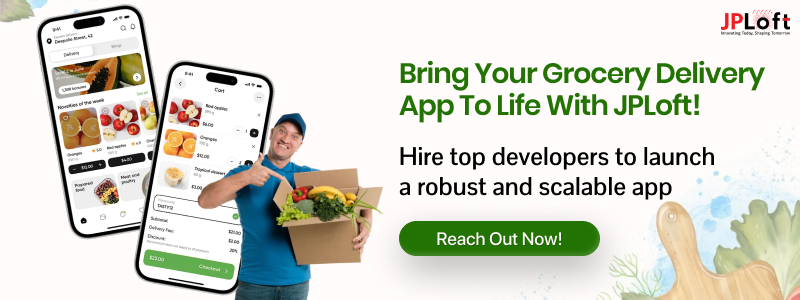
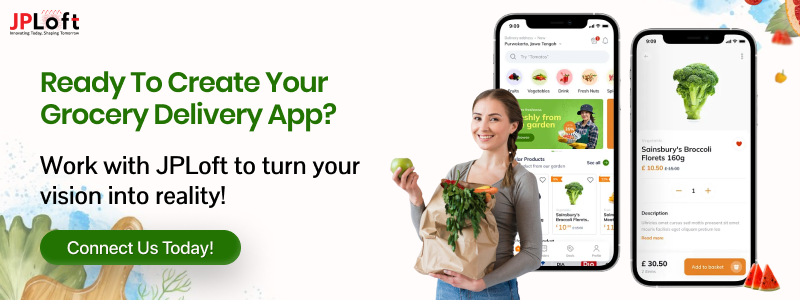

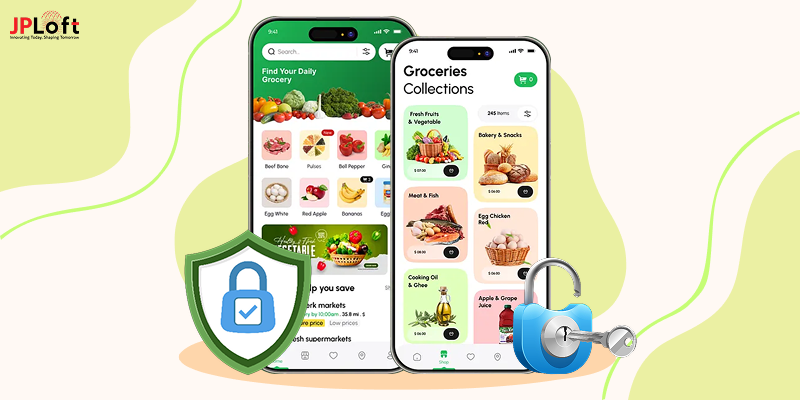
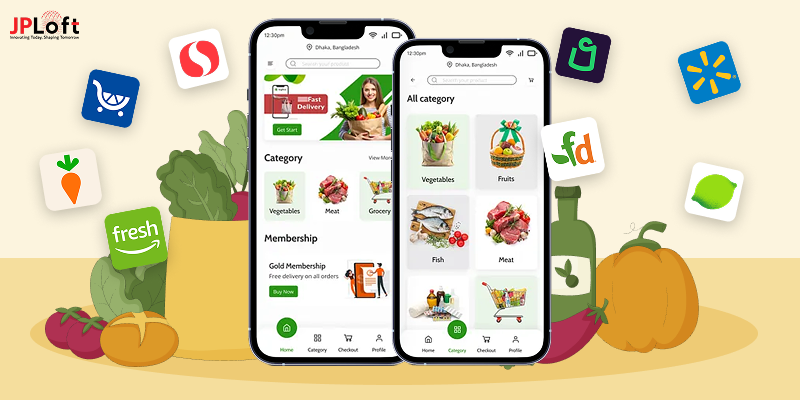
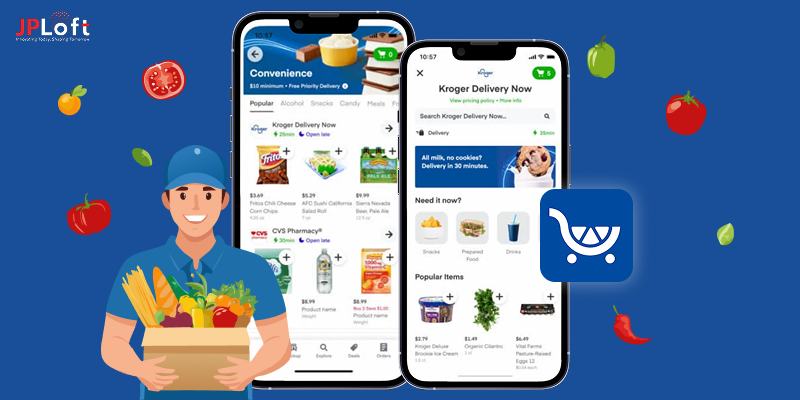


Share this blog